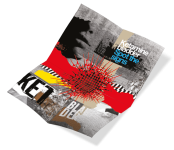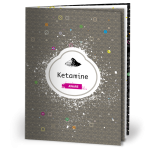Ketamine harm reduction: a guide for drug workers & services
This ketamine harm reduction guide helps drug workers and services build the knowledge and confidence to engage with and support people who use ketamine
More people are using ketamine
Ketamine use has increased in recent years and is now common across a wide range of social settings. It was once mainly linked to the gay club scene but is now widely used at festivals, in student nightlife, and among people who use multiple drugs. In England and Wales, 3.8% of 16–24-year-olds — approximately 220,000 young adults — reported using ketamine in the past year (2022/23), the highest level recorded to date. Among adults aged 16–59, 0.8% — roughly 300,000 people — reported past-year use (ONS, 2024).
While many people use ketamine recreationally and without significant problems, drug services and outreach workers are reporting growing concerns. Some users are developing more frequent, chaotic, or dependent patterns of use, which can lead to a range of adverse side effects. As ketamine use continues to rise, drug workers and services are encountering more people who may benefit from harm reduction advice and support.
What is ketamine
Ketamine is an anaesthetic drug with dissociative effects. It was first developed in the 1960s and became widely used in surgery during the 1970s and 1980s. These days, it is used less often for routine operations but is still used in trauma cases such as burns or traffic accidents because it helps manage pain while maintaining breathing and blood pressure.
Is ketamine really a horse tranquilliser?
Ketamine is still used in human medicine in certain situations, such as emergency care and paediatrics but it is more commonly used as an anaesthetic in veterinary surgery — probably the source of the popular ‘horse tranquilliser’ misnomer. As a marketing ploy, something that could knock out a horse sounds like a winner for dealers and for media looking for an eye-catching headline. Even though it is mainly used on a wide range of small animals, ‘hamster tranquilliser’ just doesn’t have the same ring to it.
Non-medical use of ketamine
The non-medical use of ketamine became popular in the UK in the early 1990s rave scene, often sold in tablet form as ecstasy. These days ketamine is usually sold as ketamine and comes as a white powder that can be snorted (most common), swallowed (less common as it takes too long to work and acts as a laxative!), smoked (rare, as it tastes awful and wears off too quickly) or injected (very rare and not recommended).
When snorted, the effects begin within a few minutes and last around 30-45 minutes, depending on how much is taken. A common method in a club would be to dip the end of a key into the bag of powder and sniff a small amount (around 200mg) from the tip, known as ‘keying’. This short duration of action leads to re-dosing at regular intervals throughout the night. If swallowed, the effects begin around 15-30 minutes and last for 1-3 hours.
What are the effects of ketamine?
Despite what many users feel, ketamine is not a depressant drug and does not slow the heart. At anaesthetic doses, it usually increases heart rate and blood pressure. However, at low doses the subjective effects are often experienced as a slowing down and heaviness of the body — sometimes known as ‘sledging’.
Sought-after mental effects include a trance-like state, disconnection from reality, feelings of floating or flying, and visual (sometimes shared) hallucinations. The ketamine experience is very dependent on the setting in which it is taken. At low doses in clubs or raves, with loud music, lights, and the buzz of the crowd, it can feel stimulating, with increased energy and euphoria.
In quieter, more relaxed settings, such as at home with friends, users report transcendental or spiritual experiences — including apparent travel to other worlds, out-of-body sensations, re-emergence of long-forgotten memories, a sense of insight into existence, time distortion, or the feeling of dying and being reborn. However, panic, unpleasant feelings, and nightmare-like experiences can also occur.
Physical effects can include loss of body control, poor coordination, difficulty speaking, moving, hearing and seeing (delirium), numbness, and nausea. Among users, ketamine has sometimes been described as ‘psychedelic heroin’ or ‘L.A. coke’, highlighting the mixed and complex nature of its effects.
Short-term mental effects of ketamine
-
Short-term mental effects
-
Out-of-body experiences
-
Shifts in perception of reality
-
Confusion or disorientation
-
Pleasant mental and/or body high
-
Increased energy
-
Euphoria
-
Sense of calm and serenity
-
Meaningful or spiritual experiences
-
Enhanced sense of connection with the world (people, beings, objects)
-
Distortion or loss of sensory perceptions (common)
-
Open- and closed-eye visual hallucinations (common)
-
Dissociation of mind from body
-
Significant changes in the perception of time
Short-term physical effects
- Increased heart rate
- High blood pressure (hypertension)
- Respiratory depression (rare with ketamine alone but more likely when mixed with other depressants)
- Hypersalivation (excess saliva)
- Nausea
- Slurred speech
- Numbness and reduced sensitivity to pain (analgesia)
- Loss of coordination (ataxia)
What are the problems of using ketamine?
The main immediate risk with ketamine use is physical helplessness. Disconnection from the body, combined with loss of coordination and awareness, can be dangerous — especially in the disorienting environment of a club or rave. This is similar to being extremely drunk in a public place, where accidents are more likely. It can also leave users vulnerable to assault (physical or sexual) and to unprotected sex, increasing the risk of unplanned pregnancy, sexually transmitted infections (STIs) such as gonorrhoea, and blood-borne viruses (BBVs), including hepatitis B, hepatitis C, and HIV.
Fatal overdose from ketamine alone is very rare, as it typically does not cause life-threatening respiratory depression. However, loss of consciousness is dangerous in itself. If someone becomes unconscious after using ketamine, this is an emergency and should be treated as such.
Mixing ketamine with other drugs
Nowadays, many people use multiple drugs together, and ketamine is no exception. On a night out, people who use ketamine often combine it with substances such as alcohol (which increases risks), cocaine, and a range of newer compounds known as novel psychoactive substances (NPS).
There is also the added risk that ketamine may be contaminated with other substances — including potent opioids such as nitazenes — without the user’s knowledge. Contamination is an increasing concern in some drug markets, including ketamine.
Mixing drugs greatly increases risks, as the effects are unpredictable and harder to manage.
Is ketamine addictive?
Although not considered physically addictive, tolerance to ketamine builds up very quickly and higher doses are needed to achieve the desired effects. As mentioned earlier, some users are getting into patterns of compulsive binges.
This can lead to problems with memory, word/name recall, reduced attention span, damage to relationships, loss of productivity, isolation, and neglecting other interests. Despite evidence of harm the compulsive user often finds it difficult to cut down, all the hallmarks of dependence.
Distressing psychological effects of using ketamine
- Anxiety and panic attacks
- Depression and suicidal thoughts
- Insomnia and sleep disturbances (including nightmares)
- Flashbacks and persistent perceptual changes
- Feelings of unreality or detachment from the world (depersonalisation, derealisation)
- Paranoia
Bladder damage from ketamine use
There is clear evidence that heavy ketamine use can cause serious physical damage to the bladder and urinary tract. Some users develop a condition known as ulcerative cystitis, with symptoms such as:
- a frequent and urgent need to urinate
- pain or burning during urination
- blood in the urine
- urinary incontinence
These symptoms are linked to scarring and shrinking of the bladder. If ketamine use continues, the damage can become irreversible and may also lead to kidney problems.
For more on bladder-related complications, see our harm reduction page on ketamine bladder symptoms, k cramps & what to do about them.
What are K-cramps?
K-cramps (also called K-pains) refer to severe abdominal pain experienced by many people who use ketamine heavily. The exact cause is not fully understood, but is believed to involve irritation or damage to the gastrointestinal tract and gallbladder, and may also be linked to bladder-related complications.
K-cramps are most commonly reported by people taking high doses (such as more than a gram a day) or using ketamine daily. However, some people experience symptoms with frequent or prolonged use even at lower doses.
Is ketamine illegal?
Ketamine is illegal. Under the Misuse of Drugs Act (1971) it is a Class B drug. The maximum penalty for possession is five years in jail plus an unlimited fine. The maximum penalty for supplying to another person (dealing or giving away) is 14 years imprisonment plus an unlimited fine.
If you support people who use ketamine this is how you can help
The law
Let’s take that last point first. Ketamine is illegal. If the client wants to avoid the risk of arrest, prosecution, fine, jail or a criminal record – don’t go near ketamine. Simple. All ketamine users should be made aware of the legal risks they run.
Engagement
It is quite likely that mainstream drug services will not see ketamine users presenting for help. This is due, in part, to services being set up to deal with other drugs and are not geared towards the needs of ketamine users. This will also be the perception of ketamine users who don’t see themselves in the same league as heroin or crack users and may feel unwilling to attend such a service.
Contact is more likely to be made through advertising, in the appropriate places, your agency as a more broad-based service, ready and willing to support all forms of drug user. It is not the drug that is important but the behaviour. If you can get this across you may attract a more diverse clientele.
Even more effective will be outreach workers who can get to know ketamine users on their own terms. This approach has proved useful in many areas and helps to provide a bridge into mainstream provision. Outreach workers can also act as an early warning system, picking up on new trends developing in the community before individuals arrive on your doorstep needing help.
If you don’t currently have an outreach team, get one.
Education
Making ketamine users aware of the potential risks, particularly when mixed with other drugs, and ways of reducing harm is vital. How this information is put across will also determine the uptake of the service. Unrealistic, scaremongering will put people off, whereas honest, non-sensational, culturally attuned awareness raising will engage more effectively.
But, to be effective, it’s the credibility of the sender rather than the message itself that is often more important. If your agency has a user-friendly, non-punitive reputation in the community then individuals will feel more comfortable about coming forward. This is where outreach, again, can prove useful. Outreach workers can gain the trust of clients and explain what your service has to offer, as well as providing advice and information at the point of contact.
Vulnerability
Friends shouldn’t need reminding that, on a night out, they must look after each other. Even so, it’s worth reinforcing the message that if someone is really out of it they are vulnerable to all kinds of danger.
So make a plan before going out – stick together, agree meeting places if you get separated, before you go out order a taxi to pick you all up afterwards, make sure everyone has got each other’s phone numbers, try to keep tabs on who has taken what and how much. If someone is really out of it they should never be left alone or put in a taxi to be taken home on their own. They may not be in a fit state to make rational decisions, so they should not go off with their new ‘best friends’.
This may sound improbable, and boring, but if it’s not discussed no-one will think about it.
Collapse and unconsciousness
All drug users need to know how to react if someone collapses and this is important knowledge that you can pass on. Because of the ‘sledging’ effects of ketamine, this may prove very important.
Simple First Aid techniques (recovery position, stay with them + call an ambulance), applied at the point of need, saves a lot of bother. If you don’t currently teach First Aid to your clients, see about setting something up.
Compulsive use
Remember, it’s the behaviour not the drug. Some ketamine users find the escape from reality is a relief from feelings or memories they can’t control, in the same way that users of heroin, for example, find solace in the numbness that drug brings.
Clients who feel they can’t control their ketamine use are no different from the alcohol or heroin user who feels they can’t control their use either. An experienced worker will know where to use a brief intervention, how to assess need, or when to suggest more in-depth interventions such as CBT or MI.
Brief interventions, such as quantifying consumption, exploring the pros and cons of using or keeping a diary of use, has been shown to be very effective in reducing alcohol consumption. It has been used successfully with other drugs, so why not ketamine? Helping a client to define their frequency and level of use, and the gains to be made by cutting down, can help to break up patterns of consumption.
Cognitive Behavioural Therapy (CBT) has been used successfully in helping clients understand their motivation to use other drugs and could be equally applied to ketamine. Understanding how patterns of behaviour develop, identifying cues and triggers that stimulate the desire to use, and devising strategies to cope with high-risk situations can all help to bring about change.
And change is the goal. If a client is concerned enough about some aspects of their ketamine use, a Motivational Interviewing (MI) approach can help to identify how change can be incorporated into behaviour. Maintaining that change over time will help move the client through the process and into a less harmful situation.
Mental health
Ketamine has profound psychological effects. It can take the user to some very strange places inside their own head. If they do have unpleasant or suppressed memories, or do have an underlying or overt mental health issue then ketamine could exacerbate these. If the client does have a bad experience they should stop using ketamine immediately. If something has come to the surface that won’t go away, they should seek help from their GP.
Most people who have a bad, transitory ketamine experience will return to normal and will have learned an important lesson - Ketamine is an interesting place to visit, but you wouldn’t want to live there. For many, this will help them re-evaluate the desire for a trip to the dark side and possibly deter them in future.
Physical health
Most of the physical problems associated with ketamine are due to accidents whilst under the influence. At high doses, numbness in the extremities (mainly fingers and toes) is not unusual, but this might mask a broken bone that does not become apparent until the ketamine wears off. Looking after each other when on a night out is good advice, but if everyone’s in the K-hole it’s not much use. In the event of an accident or fall, making others (bar staff, security, First Aiders, etc.) aware that ketamine has been used could help avoid major injuries going unnoticed.
As stated above, some heavy users of ketamine have developed bladder problems. If any of the symptoms outlined above are experienced, it makes good sense to stop using ketamine altogether and seek medical advice. As for K-cramps, even though the exact cause is unclear it has been suggested that Tyrosine, used only under medical supervision, can help alleviate the pain.
This content is provided for harm reduction and educational purposes and is not a substitute for professional medical advice.
Please share this guide with people who use ketamine, their friends and families, and other professionals who may find it helpful.
Order ketamine leaflets and booklets to use with your service users.




















